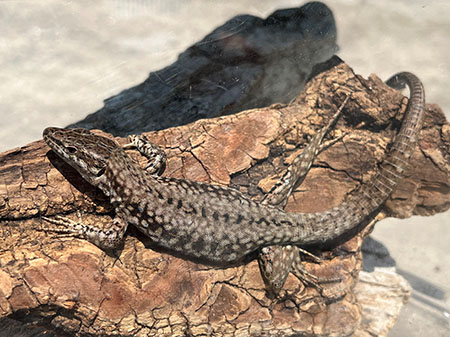
Description
Common wall lizards (Podarcis muralis) are approximately 5½ to 8 inches in length as adults and usually have a brown or gray back with mottling or spotting on the sides. Some individuals have a reticulated pattern on the back.
Status
The common wall lizard is a European species that became established in Cincinnati during the early 1950s after several individuals were intentionally released. This non-native species has since colonized much of the Cincinnati area, including parts of northern Kentucky, and is currently expanding into nearby areas of southwest Ohio and southeast Indiana.
In 2004, wall lizards were discovered at Falls of the Ohio State Park in Clark County. The Indiana DNR quickly launched an eradication program that ran from 2005 to 2007. After that effort, wall lizard numbers appeared to decline, and DNR herpetologists and state park personnel have not observed these lizards at Falls of the Ohio since 2010. The origin of wall lizards at the state park is not fully known, but they are suspected to have arrived on river debris on the Ohio River or possibly by intentional introduction.
In July of 2023, DNR Division of Fish & Wildlife biologists located a colony of common wall lizards during surveys for the species in Lawrenceburg, about two miles from the Ohio state line. The biologists observed an estimated 20–35 wall lizards of various ages living in a rock-lined embankment bordering the Ohio. Since the initial discovery at Lawrenceburg, members of the public and DNR have identified wall lizards in the nearby communities of Aurora and Rising Sun. These sites are along the Ohio, where the lizards reside in the river’s rocky and vegetated banks and a nearby rock wall. DNR is conducting additional surveys to better understand the occurrence of this lizard in southeast Indiana.
Help the Indiana DNR by Reporting Sightings
Additional survey work is needed to determine if common wall lizards have become established at other sites in southeast Indiana. Sightings, especially those backed by photographs, should be directed to HerpSurveys@dnr.IN.gov.
Indiana Range
The current known range of wall lizards includes the southeast corner of Dearborn County and eastern Ohio County. Colonies have been identified in Lawrenceburg, Aurora, and Rising Sun, but surveys are being conducted to determine the extent of wall lizard colonization in this area.
Diet
Common wall lizards have a diet that includes insects such as crickets and grasshoppers. They may also eat earthworms.
Habitat
Common wall lizards tend to occupy urban and suburban areas where they inhabit stone walls, rubble heaps, loose stone, degraded building infrastructure, and rocky hillsides. Indiana populations occur along the banks of the Ohio. Population densities may reach up to 1,500 lizards per acre in certain areas.
Management
Common wall lizards are not native to North America and are not generally dangerous. There is some concern among herpetologists that common wall lizards may outcompete native species like common five-lined skinks for food and shelter, though more research is needed to understand their interactions. Controlling smaller, more isolated common wall lizard colonies may be possible in some instances; however, successfully managing large colonies or those supplemented by nearby source populations may not be possible. Further work is needed to determine the extent of colonization in southeast Indiana and if the DNR will consider management actions.

